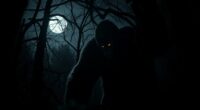When investigating cryptid evidence like footprints, photos, and DNA, you need to examine each carefully. Look for signs of natural causes, manipulations, or hoaxes. Footprints should match known animal tracks, while photos must be scrutinized for editing or ambiguity. DNA samples require lab analysis to identify species or uncover novelty. Critical evaluation helps distinguish genuine evidence from plausible misdirection. If you want to learn how to spot the truth, there’s more to contemplate beyond the surface.
Key Takeaways
- Analyzing footprint patterns for consistency, size, and comparison with known animal tracks helps determine authenticity.
- Scrutinizing photographic metadata and signs of editing is essential to verify the genuineness of images.
- Laboratory testing of DNA samples identifies species or detects potential novelty, with careful contamination control.
- Scientific skepticism requires rigorous verification and physical proof before accepting cryptid claims as credible.
- Critical evaluation of all evidence types—footprints, photos, and DNA—is vital for objective investigation of cryptid sightings.

Cryptid sightings have captivated the curiosity of many, fueling debates over the existence of creatures hidden in our world’s unexplored corners. When you come across reports of mysterious footprints, strange photographs, or DNA evidence, it’s natural to feel a mix of excitement and skepticism. These pieces of evidence often spark intense discussions between believers, who see them as potential proof of cryptids, and scientists, who demand rigorous verification. As you investigate these claims, you quickly realize that paranormal sightings can be highly subjective and prone to misinterpretation. Many supposed encounters are later identified as misidentifications of known animals, optical illusions, or hoaxes. This is where scientific skepticism becomes your best tool. It pushes you to ask critical questions: Is there concrete, verifiable evidence? Has the evidence been tested under controlled conditions? Are there alternative explanations that don’t involve supernatural or cryptid entities? Recognizing the importance of scientific methods helps ensure that investigations are grounded in objective analysis rather than speculation.
When examining footprints, your first step is to analyze their size, shape, and depth. Many alleged cryptid tracks are found in remote areas, but that doesn’t automatically make them authentic. Natural causes, like animal activity or weather conditions, can create prints that seem unusual or exaggerated. Sometimes, people intentionally carve footprints as part of hoaxes. You need to look for consistent patterns, such as multiple prints in sequence, and compare them to known animal tracks. Photos can be tricky; digital images are easy to manipulate, so you should scrutinize the metadata and look for signs of editing. Clear, detailed photos are rare, and many purported cryptid images are blurry or ambiguous. DNA evidence, however, offers a different perspective. If you come across hair, blood, or tissue samples, you can have them analyzed in a laboratory. But even here, contamination and misidentification are issues. DNA results must match known species or reveal something truly novel, which is rare.
In your pursuit, you’ll find that most credible scientific investigations remain unconvinced by anecdotal evidence alone. Paranormal sightings, while fascinating, often lack the physical proof needed to establish the existence of cryptids beyond reasonable doubt. Still, that doesn’t dismiss the thrill of the hunt or the allure of the unknown. Instead, it emphasizes the importance of relying on rigorous scientific methods when evaluating cryptid evidence. Whether it’s footprints, photos, or DNA, each piece must stand up to scrutiny. Only through careful analysis, skepticism, and a demand for verifiable data can you approach the truth behind these mysterious creatures lurking in the shadows of our world.
Frequently Asked Questions
How Do Cryptid Sightings Impact Local Communities?
Cryptid sightings can greatly impact your community by boosting tourism, as enthusiasts flock to see evidence or experience the mystery firsthand. They also influence cultural significance, shaping local identity and stories. While increased tourism may bring economic benefits, it can also strain resources or disrupt daily life. Overall, these sightings create a sense of intrigue that can foster community pride or, sometimes, controversy depending on how the phenomenon is received.
What Are the Most Common Locations for Cryptid Evidence?
Imagine shadowed forests and misty lakes as secret stages where cryptid evidence appears. You’ll find these elusive creatures in habitat preferences like remote mountains, dense woods, and swampy wetlands. Geographic hotspots such as the Pacific Northwest, Appalachian Mountains, and the Amazon hold the most clues. These locations, cloaked in mystery, become the battleground where footprints, photos, and DNA hint at creatures lurking just beyond our sight.
Can DNA Analysis Definitively Prove Cryptid Existence?
DNA analysis alone can’t definitively prove cryptid existence, but genetic verification combined with forensic breakthroughs can strongly support claims. When you examine DNA samples from cryptid evidence, you might identify unknown or unclassified species, but it doesn’t confirm a cryptid’s existence outright. Instead, it provides compelling leads for further investigation, helping you separate genuine cases from hoaxes or misidentifications.
How Do Experts Differentiate Between Hoaxes and Genuine Evidence?
Think of cryptid evidence like a detective’s case: you look for clues that stand out. Experts use hoax detection techniques, such as examining footprints for tool marks or photo analysis for inconsistencies. They also validate evidence by cross-referencing DNA results with known species. If an anomaly appears, they dig deeper, questioning authenticity. This careful process helps separate genuine signs from clever hoaxes, ensuring only credible evidence moves forward.
What Future Technologies Could Aid Cryptid Investigations?
Future technologies like biometric identification could help verify cryptid sightings by analyzing unique features, while environmental sensors can detect unusual activity or biological traces. You might use advanced AI to process footage, distinguishing genuine sightings from hoaxes. These tools enable you to gather more precise evidence, increasing credibility. As technology evolves, your investigations become more accurate, helping to uncover the truth behind cryptid mysteries with greater confidence and clarity.
Conclusion
So, as you examine footprints, photos, and DNA evidence, you might wonder if these clues point to real cryptids lurking among us. While science seeks answers, the mystery remains enthralling. Will future discoveries finally prove these creatures exist, or will they forever stay hidden in legend? The truth might be out there, waiting to be uncovered. Are you ready to keep searching for the answers that could change everything?









